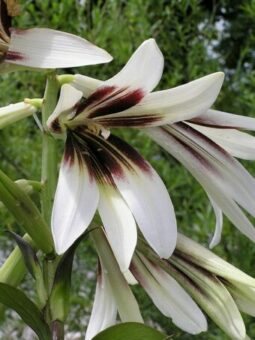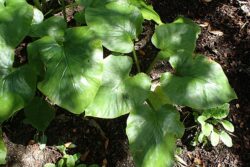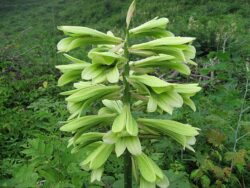In this article, we will discuss how to grow the imposing, yet beautiful bulb of Cardiocrinum in Containers. Cardiocrinum is a bulbous plant belonging to the Liliaceae (the Lily) family and was first described in 1846. It is found growing in woodlands on the soil surface in china, Far East Russia, the Himalayas and Japan. Once you see one in flower, you will not forget, especially if you grow the giant version. In total, 3 species are known but the giant one is usually grown in the UK gardens.

Cardiocrinum giganteum is the main species. It can grow to 4m in height and is essentially a massive bulb that once planted produces a huge rosette of glossy, dark green dinner plate-sized, heart-shaped leaves. Each leaf can be 30cm in length and often have a bronze/purple tinge when young.
The plant is not grown for its leaves although they are attractive, it is for the 1.5 to 4m tall, stout flowering spikes that appear in July and August. On top of these stems up to 16 and 20 white, bell-shaped flowers are produced that have reddish markings on the inside. Not only will the beauty take your breath away, but it is also fragrant as well.
If you are after an unusual plant that will take your breath away, then find out how to grow the bulb of Cardiocrinum in containers.
GROWING CARDIOCRINUM IN CONTAINERS
Although you can find bulbs, there are few suppliers but there is an alternative as you can grow from seeds bought in specialist online stores.
The biggest problem is that it is a very slow grower. Planted new bulbs can take 2 years to flower, whilst seed-grown specimens can take up to 7 years. This is not a plant for an instant show as you will have to be patient.
GROWING CARDIOCRINUM FROM SEED
If you manage to find a supplier of Cardiocrinum seeds and you want an impressive tall species, then this is the way to go. As said previously this is very slow, taking years for the plant to flower.
First, you will need to fill a 15cm sized pot full of seed sowing compost. Make sure the compost is moist at all times, so water it before you sow the seeds. On top of the compost place one seed and just cover it with a layer of fine vermiculite. Place the container outside in a sheltered area (a cold frame is ideal) as they need a temperature of 13 to 15 degrees Celsius to germinate. This is why starting your seeds in March and April is an ideal time to do so.
The compost must not be allowed to dry out at any time, but never overly wet as well. Be warned, it is very slow to get started, taking 3 months to 2 years to emerge. Allow it to grow on when it starts to germinate until the roots start poking through the drainage holes at the bottom. You will need to pot on to the next pot size up filled with multipurpose compost and allow it to grow on until the plant is well-established and growing healthily. It can be planted out in a container at this stage.
PLANTING VIA BULBS OR OFFSETS
In October, you can plant the bulb 15cm deep and only plant one per container. In a container, you will have the advantage of tailoring the growing media to the plant in question.

First, choose an as large and deep container as possible (a deep half barrel will be ideal). The larger and deeper it is the better it will be for the plant. Make sure it has plenty of drainage holes at the bottom to allow excess moisture to escape. On top of this add a good quality, moisture-retentive, multipurpose compost to which a couple of handfuls of leaf mould have been added. Make sure the compost is well watered at this stage.
In the centre, you can either plant one bulb as described above or one plant. To do this, dig a deep hole that is slightly larger than the root ball it came in the original container you grew. Place the plant in so that the top of the root ball is at the same level as the top surface of the compost. Backfill with the growing media ensuring no gaps remain, using more compost if necessary. Firm the plant in and water again.
CARE INSTRUCTIONS
The plant likes to grow in a woodland-type environment and so must be planted in dappled shade. This is to prevent the leaves from getting sun-scorched. Place the container where this growing condition can be met.
It will need to be watered regularly and soon as the surface of the compost feels dry to the touch. You will need to fertilize with a general liquid fertilizer (such as Phostrogen) during the growing season and especially so during the flowering period to get the best show.
After it has finished flowering, the main bulb dies but offsets are produced. Thin small bulblets will be produced in October after the top growth has died back. These small plants growing at the base can be removed and potted on. After 3 to 5 years these will become your new flowers. You must release that there will be 3 to 5 years gaps between flowers and it will not produce every year.
The stems are stout and so will not need supporting, but the container may need to be weighted to stop it from topping over. After it has finished flowering, you will need to cut the spent stem down and plant the offset as recommended earlier.
Remember newly planted bulbs will take two years to flower.
PESTS AND DISEASES
It may be a tall and beautiful plant but pests do attack them, but not so much so for diseases. If anybody is aware of plants in the lily family, lily beetles can be a total menace. Best treated by handpicking and crushing underfoot.

Slugs, voles and mice can dig up and eat the bulbs, whilst slugs will nibble on the bulb. You will need to protect by using slug/snail pellets or by using wool deterrent matting.
VARIETIES TO GROW
The one variety and species to find and grow is C. giganteum described in detail in the introduction. The one worth growing is C. giganteum var. yunnanense, the Giant Yunnan lily.
Other possible and newly developed species are C. cordatum and C. cathayanum.
CONCLUSIONS
In this article, we have discussed how to grow the impressive specimen of Cardiocrinum in containers. They may not flower straight away and die after doing so, but if you want a plant that will take your breath away then this is for you.
Not a plant for those who are impatient.
If you have any comments or questions that you have on growing Cardiocrinum in containers, then please do so in the comment box below.
Happy Cardiocrinum growing.
